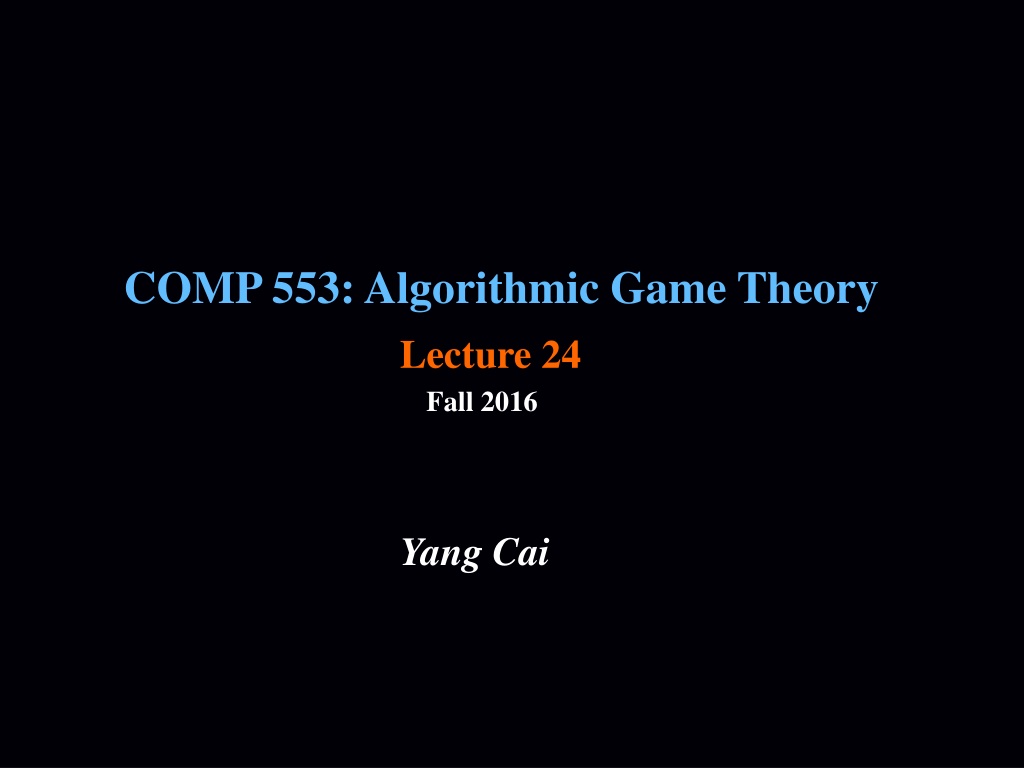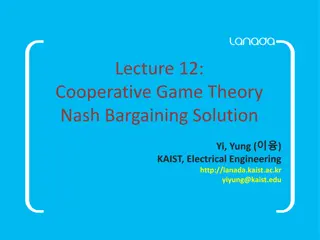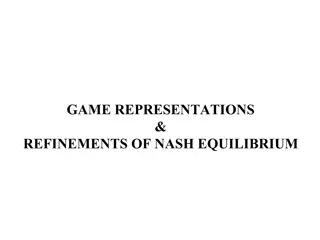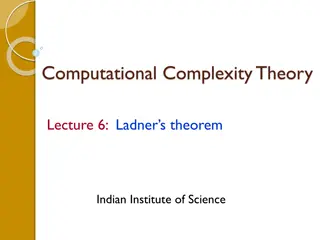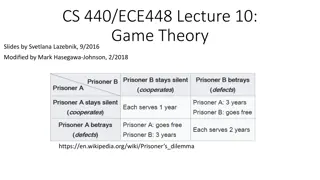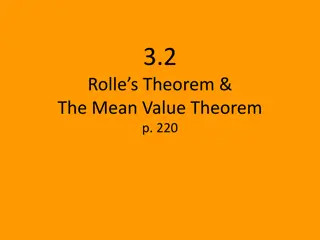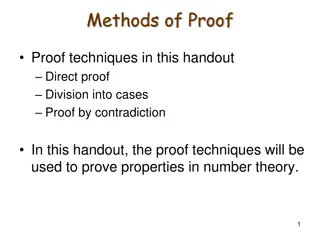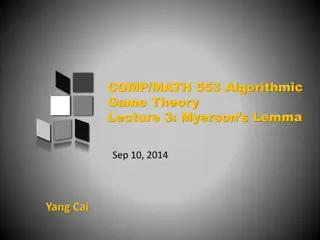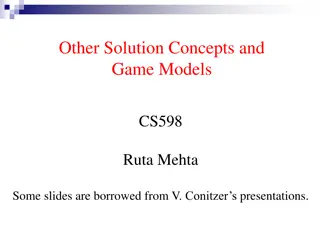Understanding Brouwer's Fixed Point Theorem and Nash's Proof in Algorithmic Game Theory
Explore the foundational theorems of Brouwer and Nash in Algorithmic Game Theory. Dive into Brouwer's Fixed Point Theorem, showcasing the existence of fixed points in continuous functions. Delve into Nash's Proof, unveiling the Nash equilibrium in game theory. Discover visualizations and constructions that elucidate these fundamental concepts.
Download Presentation

Please find below an Image/Link to download the presentation.
The content on the website is provided AS IS for your information and personal use only. It may not be sold, licensed, or shared on other websites without obtaining consent from the author. Download presentation by click this link. If you encounter any issues during the download, it is possible that the publisher has removed the file from their server.
E N D
Presentation Transcript
COMP 553: Algorithmic Game Theory Lecture 24 Fall 2016 Yang Cai
In the beginning of the semester, we showed Nashs theorem a Nash equilibrium exists in every game. In our proof, we used Brouwer s fixed point theorem as a Black- box. In today s lecture, we explain Brouwer s theorem, and give an illustration of Nash s proof. We proceed to prove Brouwer s Theorem using a combinatorial lemma, called Sperner s Lemma, whose proof we also provide.
Brouwers fixed point theorem Theorem:Let f : D D be a continuous function from a convex and compact subset D of the Euclidean space to itself. Then there exists an x s.t. x = f (x) . closed and bounded Below we show a few examples, when D is the 2-dimensional disk. f D D N.B. All conditions in the statement of the theorem are necessary.
Brouwers fixed point theorem fixed point
Brouwers fixed point theorem fixed point
Brouwers fixed point theorem fixed point
Nashs Function where:
Visualizing Nashs Construction Kick DiveLeft Right : [0,1]2 [0,1]2, continuous such that fixed points Nash eq. Left 1 , -1 -1 , 1 Right -1 , 1 1, -1 Penalty Shot Game
Visualizing Nashs Construction Pr[Right] 0 1 0 Kick DiveLeft Right Pr[Right] Left 1 , -1 -1 , 1 Right -1 , 1 1, -1 1 Penalty Shot Game
Visualizing Nashs Construction Pr[Right] 0 1 0 Kick DiveLeft Right Pr[Right] Left 1 , -1 -1 , 1 Right -1 , 1 1, -1 1 Penalty Shot Game
Visualizing Nashs Construction Pr[Right] 0 1 0 Kick DiveLeft Right Pr[Right] Left 1 , -1 -1 , 1 Right -1 , 1 1, -1 1 Penalty Shot Game
Visualizing Nashs Construction Pr[Right] 0 1 0 Kick DiveLeft Right Pr[Right] : [0,1]2 [0,1]2, cont. such that fixed point Nash eq. Left 1 , -1 -1 , 1 Right -1 , 1 1, -1 1 Penalty Shot Game fixed point
Sperners Lemma no yellow no blue no red Lemma: Color the boundary using three colors in a legal way.
Sperners Lemma no yellow no blue no red Lemma: Color the boundary using three colors in a legal way. No matter how the internal nodes are colored, there exists a tri-chromatic triangle. In fact an odd number of those.
Sperners Lemma Lemma: Color the boundary using three colors in a legal way. No matter how the internal nodes are colored, there exists a tri-chromatic triangle. In fact an odd number of those.
Sperners Lemma Lemma: Color the boundary using three colors in a legal way. No matter how the internal nodes are colored, there exists a tri-chromatic triangle. In fact an odd number of those.
Proof of Sperners Lemma For convenience we introduce an outer boundary, that does not create new tri- chromatic triangles. Next we define a directed walk starting from the bottom-left triangle. Lemma: Color the boundary using three colors in a legal way. No matter how the internal nodes are colored, there exists a tri-chromatic triangle. In fact an odd number of those.
Proof of Sperners Lemma Space of Triangles Transition Rule: If red - yellow door cross it with red on your left hand. ? 2 1 Lemma: Color the boundary using three colors in a legal way. No matter how the internal nodes are colored, there exists a tri-chromatic triangle. In fact an odd number of those.
Proof of Sperners Lemma For convenience we introduce an outer boundary, that does not create new tri- chromatic triangles. Claim: The walk cannot exit the square, nor can it loop around itself in a rho-shape. Hence, it must stop somewhere inside. This can only happen at tri-chromatic triangle Next we define a directed walk starting from the bottom-left triangle. ! Starting from other triangles we do the same going forward or backward. Lemma: Color the boundary using three colors in a legal way. No matter how the internal nodes are colored, there exists a tri-chromatic triangle. In fact an odd number of those.
